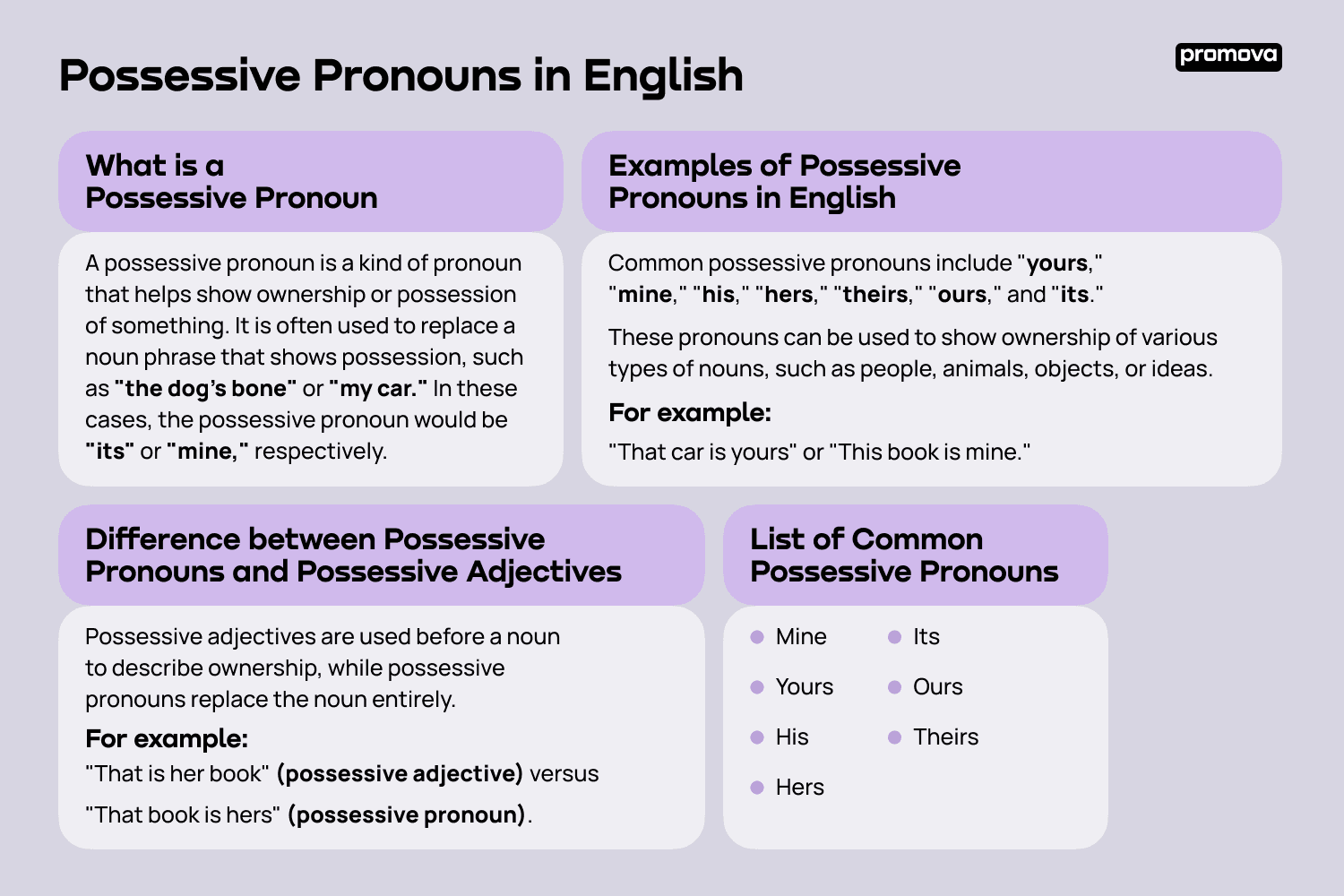Possessive Pronouns in English
Contents
In this reference, we will explore possessive pronouns and how to use them correctly. You'll learn what they are, find a lot of handy examples, and learn to include them in your sentences. Let's start learning!
What is a Possessive Pronoun
A possessive pronoun is a kind of pronoun that helps show ownership or possession of something. It is often used to replace a noun phrase that shows possession, such as "the dog's bone" or "my car." In these cases, the possessive pronoun would be "its" or "mine," respectively. Understanding how to use possessive pronouns correctly can help you communicate more effectively in English.

Examples of Possessive Pronouns in English
There are many examples of possessive pronouns in English, each with their own specific use. Common possessive pronouns include "yours," "mine," "his," "hers," "theirs," "ours," and "its." These pronouns can be used to show ownership of various types of nouns, such as people, animals, objects, or ideas. For example, "That car is yours" or "This book is mine."
Another example of a possessive pronoun is "ours," which shows ownership of something shared by a group. For instance, "This is our house" or "Our team won the game." Possessive pronouns can also help show possession in a more abstract sense, such as "The idea was hers" or "The decision is yours."
List of Common Possessive Pronouns
Here is a full list of all possessive pronouns in English:
- Mine
- Yours
- His
- Hers
- Its
- Ours
- Theirs
Each of these pronouns can be used to show ownership or possession in different contexts, depending on the noun being replaced.
Difference between Possessive Pronouns and Possessive Adjectives
Note that possessive pronouns are different from possessive adjectives, which are also used to show possession. Possessive adjectives are used before a noun to describe ownership, while possessive pronouns replace the noun entirely. For example, "That is her book" (possessive adjective) versus "That book is hers" (possessive pronoun).
7
How to Use Possessive Pronouns in Sentences
Using possessive pronouns in sentences is fairly straightforward, but it is important to use them correctly to communicate effectively. Possessive pronouns should be used when replacing a noun phrase that shows ownership or possession. For example, "This is my car" can be replaced with "This car is mine." In this case, "mine" is the possessive pronoun that replaces the noun phrase "my car."
It is also important to use the correct possessive pronoun depending on the context of the sentence. For example, "This is your pencil" can be replaced with "This pencil is yours" or "This is hers" can be replaced with "This is her book." Using the wrong possessive pronoun can lead to confusion or misunderstandings.
Common Mistakes with Possessive Pronouns
One common mistake with possessive pronouns is using an apostrophe before the "s" in the possessive form. For example, "it's" is a contraction made from "it is," while "its" is the possessive pronoun. Another mistake is using the wrong possessive pronoun, such as using "my" instead of "mine" or "his" instead of "hers."
It is also important to note that possessive pronouns can have different forms depending on whether they are used as subjects or objects in a sentence. For example, "Mine is blue" versus "He likes mine." In the first sentence, "mine" is the subject of the sentence, while in the second sentence, "mine" is the object of the verb "likes."
Summary
Possessive pronouns are an important part of English grammar that can help you communicate ownership or possession more effectively. Understanding the difference between possessive pronouns and possessive adjectives, as well as how to use possessive pronouns in sentences, can help you avoid common mistakes and communicate more clearly.
By practicing with examples of possessive pronouns and using them correctly in sentences, you can improve your English skills and become a more confident learner. Good luck on your journey!



Comments